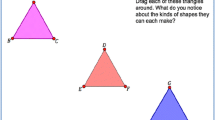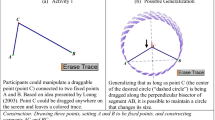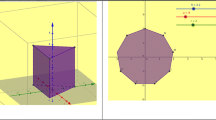Abstract
In this paper, we investigate children’s learning of reflectional symmetry in a dynamic geometry environment. Through a classroom-based intervention involving two 1-h lessons, we analyse the changes in the children’s thinking about reflectional symmetry: first, they developed dynamic and embodied ways of thinking about symmetry after working with a pre-constructed sketch called the “symmetry machine”. Secondly, they moved from distinguishing symmetrical and asymmetrical figures statically to generalising about properties of symmetry. This was evident in the way children expressed symmetric movement through words, gestures and diagrams during the computer-based lessons as well as in the follow-up paper-and-pencil tasks. We highlight the specific roles of the teacher and of the digital technology in supporting the process of semiotic mediation through which the children learned symmetry.








Similar content being viewed by others
Notes
The historical-epistemological root of this kind of transformation can be found in Ponselle’s principle of continuity which states that “if we suppose a given figure to change its position by having its points undergo a continuous motion without violating the conditions initially assumed to hold between them, the […] properties which hold for the first position of the figure still hold in a generalised form for all the derived figures” (cited in Greaves 2002, p. 45). In particular, continuously dragging an object will maintain the mathematical relations that were used to construct the object.
The design of this microworld was inspired by a sketch created by Michael Battista.
T = Teacher; S1 = Student 1, S2 = Student 2, etc.… Ss = All students.
References
Arzarello, F. (2006). Semiosis as a multimodal process (pp. 267–299). Numero Especial: Relime.
Arzarello, F., & Robutti, O. (2008). Framing the embodied mind approach within a multimodal paradigm, In English, L., Bartolini Bussi, M., Jones, G., Lesh, R., & Tirosh D. (Eds.), Handbook of international research in mathematics education, 2nd revised edition (pp. 720–749). New York: Routledge.
Bartolini Bussi, M. G., & Baccaglini-Frank, A. (2015) Geometry in early years: sowing seeds for a mathematical definition of squares and rectangles. ZDM Mathematics Education, 47(3) (this issue). doi:10.1007/s11858-014-0636-5.
Bartolini Bussi, M. G., & Mariotti, M.A. (2008). Semiotic mediation in the mathematics classroom: artifacts and signs after a Vygotskian perspective. In English, L., Bartolini Bussi, M., Jones, G., Lesh, R., & Tirosh D. (Eds.), Handbook of international research in mathematics education, 2nd revised edition (pp. 746–805). New York: Routledge.
Battista, M. T. (2007). The development of geometric and spatial thinking. In F. Lester (Ed.), Second handbook of research on mathematics teaching and learning (pp. 843–908). Reston: National Council of Teachers of Mathematics.
Battista, M. T. (2008). Development of the shape makers geometry microworld: design principles and research. In G. Blume & M. K. Heid (Eds.), Research on technology and the teaching and learning of mathematics: Cases and perspectives (Vol. 2, pp. 131–156). Charlotte: Information Age Publishing.
Baulac, Y., Bellemain, F., & Laborde, J.M. (1988). Cabri-Géomètre, un logiciel d’aide à l’apprentissage de la géomètrie. Logiciel et manuel d’utilisation, Paris: Cedic-Nathan.
Bornstein, M. H., & Stiles-Davis, J. (1984). Discrimination and memory for symmetry in young children. Developmental Psychology, 20(4), 637–649.
Bryant, P. (2008). Paper 5: Understanding spaces and its representation in mathematics. In Nunez, T., Bryant, P., & Watson A. (Eds.), Key understanding in mathematics learning: a report to the Nuffield Foundation. http://www.nuffieldfoundation.org/sites/default/files/P5.pdf. Accessed 18 December 2014.
Chen, C. L., & Herbst, P. (2012). The interplay among gestures, discourse, and diagrams in students’ geometrical reasoning. Educational Studies in Mathematics, 83, 285–307.
Clements, D.H., Battista, M.T., Sarama, J. (2001). Logo and geometry. Journal for Research in Mathematics Education Monograph Series, 10
Clements, D., & Sarama, J. (2004). Engaging young children in mathematics: standards for early childhood mathematics education. Mahwah: Erlbaum.
Edwards, L., & Zazkis, R. (1993). Transformation geometry: naive ideas and formal embodiments. Journal of Computers in Mathematics and Science Teaching, 12(2), 121–145.
Falcade, R., Laborde, C., & Mariotti, M. A. (2007). Approaching functions: the trace tool as an instrument of semiotic mediation. Educational Studies in Mathematics, 66, 317–333.
Goldin-Meadow, S. (2003). Hearing gesture: How our hands help us think. Cambridge: Harvard University Press.
Goldin-Meadow, S., Nusbaum, H., Kelly, S. D., & Wagner, S. (2001). Explaining math: gesture lightens the load. Psychological Science, 12, 516–522.
Greaves, M. (2002). The philosophical status of diagrams. Stanford: CSLI Publications.
Hollebrands, K. (2003). High school students’ understandings of geometric transformations in the context of a technological environment. Journal of Mathematics Behavior, 22, 55–72.
Hoyles, C., & Healy, L. (1997). Unfolding meanings for reflective symmetry. International Journal of Computers in Mathematical Learning, Technology, Knowledge and Learning, 2(1), 27–59.
Jackiw, N. (2001). The geometer’s sketchpad [Computer program]. Emeryville: Key Curriculum Press.
Jackiw, N., & Sinclair, N. (2009). Sounds and pictures: dynamism and dualism in dynamic geometry. ZDM—The International Journal on Mathematics Education, 41, 413–426.
Jagoda, E., & Swoboda, E. (2011). Static and dynamic approach to forming the concept of rotation. In M. Pytlak, E. Swoboda, & T. Rowland (Eds.), Proceedings of CERME 7 (pp. 558–567). Poland: Rzeszów.
Kaur, H. (2015). Two aspects of young children’s thinking about different types of dynamic triangles: prototypicality and inclusion. ZDM Mathematics Education, 47(3) (this issue).
Kendon, A. (2000). Language and gestures: unity or duality? In D. McNeill (Ed.), Language and gesture (pp. 47–63). Cambridge: Cambridge University Press.
Laborde, C., Kynigos, C., Hollebrands, K., & Strasser, R. (2006). Teaching and learning geometry with technology. In A. Gutierrez & P. Boero (Eds.), Handbook of research on the psychology of mathematics education: past, present, and future (pp. 275–304). Rotterdam: Sense Publishers.
Lave, J., & Wenger, E. (1991). Situated Learning: Legitimate Peripheral Participation. Cambridge: Cambridge University Press.
Mariotti, M.A. (2009) Artifacts and signs after a Vygotskian perspective: the role of the teacher, ZDM—The International Journal on Mathematics Education, 41, 427–440.
Mariotti, M.A., & Bartolini Bussi, M.G. (1998). From drawing to construction: teachers mediation within the Cabri environment. In Olivier, A., & Newstead, K., (Eds), Proceedings of the 22nd International Conference of PME (Vol. 3, pp. 247–254). Stellenbosch, South Africa.
McNeill, D. (1992). Hand and mind. What gestures reveal about thought. Chicago: University of Chicago Press.
Ng, O., & Sinclair, N. (2013). Gestures and temporality: children’s use of gestures on spatial transformation tasks. In Lindmeier, A. M., & Heinze, A., (Eds.), Proceedings of the 37th International Conference of PME (Vol. 3, pp. 361–369). Kiel, Germany.
Núñez, R. (2003). Do real numbers really move? Language, thought, and gesture: The embodied cognitive foundations of mathematics. In R. Hersh (Ed.), 18 Unconventional essays on the nature of mathematics (pp. 160–181). New York: Springer.
Perrin-Glorian, M.-J., Mathé, A.-C., & Leclercq, R. (2013). Comment peut-on penser la continuité de l’enseignement de la géométrie de 6 a 15 ans? Repères-IREM, 90, 5–41.
Schattschneider, D. (2006). Coxeter and the artists: two-way inspiration. In H. S. M. Coxeter, C. Davis, & E. W. Ellers (Eds.), The Coxeter legacy: reflections and projections (pp. 268–270). Providence: American Mathematics Society.
Schuler, J. (2001). Symmetry and young children. Montessori Life, 13(2), 42–48.
Seo, K-H., & Ginsburg, H. (2004). What is developmentally appropriate in early childhood mathematics education? In Clements, D. H., Sarama, J., & Dibias, A-M., (Eds.) Engaging young children in mathematics: standards for early childhood mathematics education (pp. 91–104). Mahwah: Erlbaum.
Sfard, A. (2008). Thinking as communicating: Human development, the growth of discourses, and mathematizing. Cambridge, England: Cambridge University Press.
Sinclair, N., & Gol Tabaghi, S. (2010). Drawing space: mathematicians’ kinetic conceptions of eigenvectors. Education Studies in Mathematics, 74(3), 223–240.
Sinclair, N., & Moss, J. (2012). The more it changes, the more it becomes the same: the development of the routine of shape identification in dynamic geometry environments. International Journal of Education Research, 51&52, 28–44.
Stylianides, A. J., & Stylianides, G. J. (2013). Seeking research-grounded solutions to problems of practice: classroom-based interventions in mathematics education. ZDM—The International Journal on Mathematics Education, 45(3), 333–342.
Vygotsky, L. S. (1978). Mind in society. Cambridge: Harvard University Press.
Wenger, E. (1998). Communities of practice. Learning, meaning and identity. Cambridge: Cambridge University Press.
Wertsch, J. V., & Stone, C. A. (1985). The concept of internalization in Vygotsky’s account of the genesis of higher mental functions. In J. V. Wertsch (Ed.), Culture, communication and cognition: Vygotskian perspectives. Cambridge: Cambridge University Press.
Weyl, H. (1952). Symmetry. Princeton: Princeton University Press.
Author information
Authors and Affiliations
Corresponding author
Rights and permissions
About this article
Cite this article
Ng, OL., Sinclair, N. Young children reasoning about symmetry in a dynamic geometry environment. ZDM Mathematics Education 47, 421–434 (2015). https://doi.org/10.1007/s11858-014-0660-5
Accepted:
Published:
Issue Date:
DOI: https://doi.org/10.1007/s11858-014-0660-5




